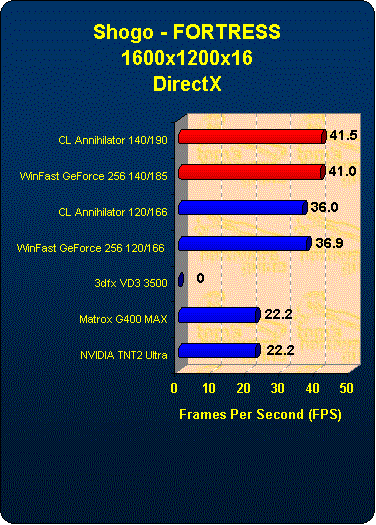Battle of the Titans: Creative Labs Annihilator vs. Leadtek WinFast GeForce 256
Overclocking
Not everyone will try to overclock their board but I tried my best and with reasonable cooling to see what each board could do. I'm sure you could go to the extreme and replace the cooling solution with something better but I wanted to test what we could get out of the shipping boards. I was surprised to see that the Leadtek board with its superior design and superior memory chips could not clock higher than the Creative board. As a matter of fact, the Creative board was able to run its memory 5 MHz faster than the Leadtek-card. I'm not sure if the memory or the board layout is to blame but I tried for hours to get things to work with no success. To be considered "stable" the boards had to run all our tests without crashing or visual defects. Fortunately each board was stable up to its limit, then it just fell off when it couldn't handle the next higher speed anymore. Keep in mind that not everyone will see the same stable settings, because the 'overclockability' depends on the individual Geforce and memory chips. Some have a higher margin than others and you might be lucky or not.
Test Configuration
| Hardware Information | |
| CPU | PIII 550 |
| Motherboard (BIOS rev.) | ABIT BX6 2.0 (BIOS date 7/13/99) |
| Memory | 128 MB Viking PC100 CAS2 |
| Network | Netgear FA310TX |
| Driver Information | |
| Reference NVIDIA TNT2 Ultra | 4.12.01.0353 |
| Creative Labs Annihilator | 4.12.01.2202.01.0348 |
| Leadtek WinFast GeForce 256 | 4.12.01.0349a |
| 3dfx Voodoo3 3500 | 4.11.01.1204 |
| Matrox G400 MAX | 4.11.01,1300 (with newest TurboGL unless specified otherwise) |
| Environment Settings | |
| OS Version | Windows 98 SE 4.10.2222 A |
| DirectX Version | 7.0 |
| Quake 3 Arena | V1.09command line = +set cd_nocd 1 +set s_initsound 0 |
| Shogo | V2.14Advanced Settings = disable sound, disable music, disable movies, disable joysticks,enable optimized surfaces, enable triple buffering, enable single-pass multi-texturingHigh Detail Settings = enabledFortress Demo |
| Descent III | Retail versionSettings = -nosound -nomusic -nonetwork -timetest |
Benchmark Results
I have included some released boards from other companies in the close price range of the GeForce boards, as well as the TNT2 Ultra, to give you an idea of where the two boards sit overall. Keep in mind that the focus of the results is on the two GeForce boards and not the existing boards on the market. They were provided for your convenience. The Matrox G400 MAX had some issues with its TurboGL and the latest version of Q3 Arena. I tried a few tricks to get the board to run properly but it just failed over and over with crashes. The default OpenGL ICD was used to generate the test scores. Also note that DMZG is unfortunately not included in this reviews test suite due to bugs that are currently being worked out of the demo. Benchmark results from DMZG at the moment are skewed by a vsync lock built into the game. We will bring the benchmark back as soon as the bug is worked out.
Shogo Results
Both GeForce boards are neck and neck even when overclocked. At this resolution the CPU can be the bottleneck as well as a slower driver. Most of the cards in the line-up are at about the same speed but this isn't the resolution why most people will have the faster graphics card for.
Now that I raised the resolution a tad we can start to see the little advantages to the overclocking. The difference between the two boards is minimal but you shouldn't be too surprised by this. The big thing you can see is how the GeForce based boards start to leave the pack behind.
At our highest resolution in Shogo, the overclocked cards shine about 5 FPS ahead of the normally clocked cards. The WinFast GeForce squeaks ahead of the stock Annihilator by almost a frame but that's not such a big deal. The remaining chipsets that were able to run in this mode stumble back as the GeForce boards rip forward. Note the 3dfx board ran with various missing textures so it failed the test.
Get Tom's Hardware's best news and in-depth reviews, straight to your inbox.
Current page: Overclocking
Prev Page The Windows98-driver Of The Leadtek WinFast GeForce 256, Continued Next Page Descent 3 DirectX Results

